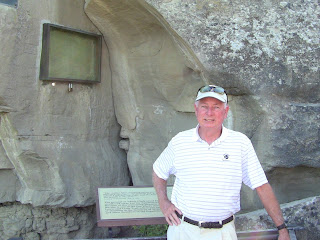Chapter Seven - Lewis and Clark Senior
Style
Pompey’s Pillar - Billings
Pompey’s Pillar - Billings
With broad
smiles of relief on our faces we watched the trailers, oil storage tanks and trucks
of Williston shrink in our rear view mirror.
Our next destination was Billings, Montana. We were not only leaving Williston we were
also leaving Lewis and Clark’s outbound route along the Missouri. Our travel plans did not include retracing
the Lewis and Clark return routes, so Russ devised a schedule for visiting the
major sites of both the outbound and return journeys of the Corps of Discovery. Our first deviation from the chronological
order of Lewis and Clark’s expedition was to follow the Yellowstone River,
which was the route of Clark’s group when the captains split the Corps on their
return trip from the Pacific Ocean.
We were
traveling West, but in July of 1806 Clark and his portion of the Corps were
paddling their canoes with the current instead of against it, as they had on
the Missouri. Charbonneau, Sacajawea and
her child, Jean Baptiste, were part of Clark’s group. Jean Baptist was a two month old infant when the
corps left Fort Mandan in April of 1805.
He had survived to be an energetic seventeen month old toddler when the
expedition reached the Yellowstone.
Clark had grown immensely fond of Jean Baptiste over the course of the
journey and called him little Pomp. (Pomp
is the Shoshone word for chief.)
As Russ
drove alongside the Yellowstone, I read some of our information pamphlets and
learned that it was the only major river in the United States that had no
dams. It was a prettier river than the
muddy Missouri and flowed freely through mostly unpopulated areas, including Yellowstone
National Park. The date was July 10 and
we were experiencing our hottest day since leaving Texas. Usually the temperature was in the
mid-eighties with an occasional dip into the seventies. Today the high was ninety-five.
Our planned stop
en route to Billings was Pompey’s Pillar and the adjoining Lewis and Clark Interpretive Center. The Pillar itself was a massive sandstone
outcropping that rose 150 feet above the banks of the Yellowstone River with no
civilization in sight. Clark named the
cliff Pompy’s Tower after Jean
Baptiste, Sacajawea’s child. It has
since been renamed Pompey’s Pillar and has been designated a National
Monument. Clark climbed the outcrop on
July 25, 1806 and carved his name and the date into the sandstone. The terrain surrounding Pompey’s Pillar was
mostly flat and climbing the sandstone outcrop provided him a magnificent view
of the surrounding terrain including the distant Rocky Mountains that the Corps
had just crossed. Clark described the
pillar as a “remarkable rock” with an “extensive view in every direction.” We climbed the two hundred steps built by the
National Park Service and had a view almost identical to Clark’s. We saw his signature on the rock which is the
only remaining on-site physical evidence of the Corps of Discovery’s expedition. It was very cool.
240 Steps to Pompey's Pillar
Yellowstone River
William Clark's Signature
The Lewis and Clark Interpretive Center at
Pompey’s Pillar was one of the best we visited.
The exhibits explained Clark’s return route and the obstacles he
overcame, as well as information
Lewis and Clark Interpretive Center at Pompey's Pillar
on the Shoshones,
Sacajawea’s native tribe before she was kidnapped by the Hidatsa and taken to
the Mandan villages. We especially liked
the air conditioning. After our climb up
two hundred steps on a ninety-five degree day, we were both spent and ready for
our hotel.
We sank into
the car and Russ drove the remaining miles to Billings, one of the largest
cities in Montana. He had booked a suite
at the Country Inn and Suites, and it was our first time to have a living room
and bedroom instead of just a bedroom. I
checked in at the reception desk and felt dizzy. Apparently the heat, climb up Pompey’s Pillar
and Billings’ altitude of 3100 feet had taken its toll on me. (I am almost seventy years old.) I told Russ I was feeling woozy as we hauled
our ‘stuff’ up to the room. Russ put the
key in the door, and I stepped into paradise.
Before me
was a refreshingly cool, darkened living room with a couch and chair opposite a
coffee table. Beyond the furniture were
two glass curtained doors inviting entry into a separate bedroom. After nearly three weeks of living in single
hotel rooms (the last one was Williston), I thought I had died and gone to
heaven. The plan was to leave in the
morning for Butte and I turned to Russ and asked, “can’t we stay more than one
night?” Russ shook his head, he was
anxious to move on, because the next stop was the headwaters of the
Missouri. “There is nothing to see
here”, he explained. Did I care? The headwaters would still be there if we
stayed another day. “We could spend a
day doing absolutely nothing,” I suggested.
The man shook his head. He was on
a mission and not to be deterred.
Disappointed, I sank into a chair before beginning to organize our
‘stuff’.




No comments:
Post a Comment